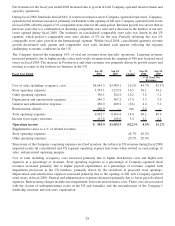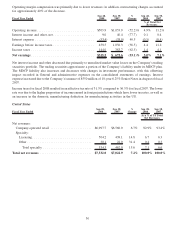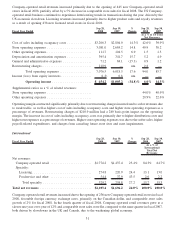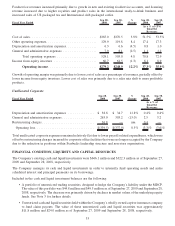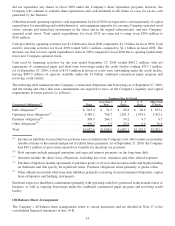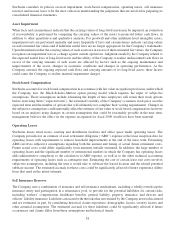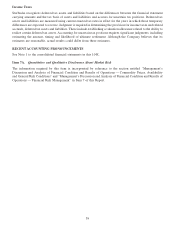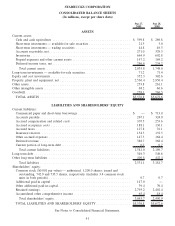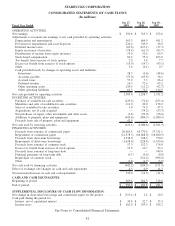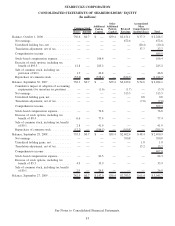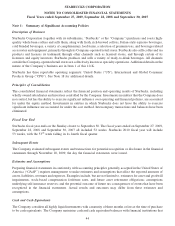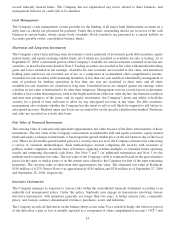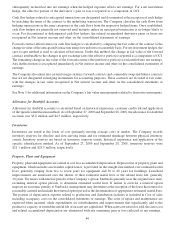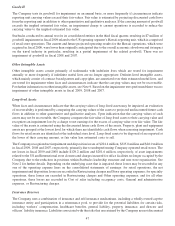Starbucks 2009 Annual Report Download - page 45
Download and view the complete annual report
Please find page 45 of the 2009 Starbucks annual report below. You can navigate through the pages in the report by either clicking on the pages listed below, or by using the keyword search tool below to find specific information within the annual report.
value of the US dollar as compared to the level of foreign exchange rates. The information provided below relates
only to the hedging instruments and does not represent the corresponding changes in the underlying hedged items
(in millions):
September 27, 2009
10% Increase in
Underlying Rate 10% Decrease in
Underlying Rate 10% Increase in
Underlying Rate 10% Decrease in
Underlying Rate
Increase/(Decrease) to Net Earnings Increase/(Decrease) to OCI
Foreign currency hedges............. $58 (58) 13 (13)
Equity Security Price Risk
The Company has minimal exposure to price fluctuations on equity mutual funds and equity exchange-traded funds
within its trading portfolio. The trading securities approximate a portion of the Company’s liability under the
MDCP. A corresponding liability is included in Accrued compensation and related costs on the consolidated
balance sheets. These investments are recorded at fair value with unrealized gains and losses recognized in Net
interest income and other in the consolidated statements of earnings. The offsetting changes in the MDCP liability
are recorded in General and administrative expenses. The Company performed a sensitivity analysis based on a 10%
change in the underlying equity prices of its investments as of the end of fiscal 2009, and determined that such a
change would not have a significant effect on the fair value of these instruments.
Interest Rate Risk
The Company utilizes short-term and long-term financing and may use interest rate hedges to manage the effect of
interest rate changes on its existing debt as well as the anticipated issuance of new debt. At the end of fiscal years
2009 and 2008, the Company did not have any interest rate hedge agreements outstanding.
The following table summarizes the impact of a change in interest rates on the fair value of the Company’s debt
(in millions):
September 27, 2009
Fair Value 100 Basis Point Increase in
Underlying Rate 100 Basis Point Decrease in
Underlying Rate
Change in Fair Value
Debt ........................ $591.8 (39.8) 39.8
The Company’s available-for-sale securities comprise a diversified portfolio consisting mainly of fixed income
instruments. The primary objectives of these investments are to preserve capital and liquidity. As of September 27,
2009, the Company’s long-term available-for-sale securities included ARS. Please see Note 3 for further infor-
mation. Available-for-sale securities are recorded on the consolidated balance sheets at fair value with unrealized
gains and losses reported as a component of Accumulated other comprehensive income. The Company does not
hedge the interest rate exposure on its available-for-sale securities. The Company performed a sensitivity analysis
based on a 100 basis point change in the underlying interest rate of its available-for-sale securities as of the end of
fiscal 2009, and determined that such a change would not have a significant effect on the fair value of these
instruments.
APPLICATION OF CRITICAL ACCOUNTING POLICIES
Critical accounting policies are those that management believes are both most important to the portrayal of the
Company’s financial condition and results, and require management’s most difficult, subjective or complex
judgments, often as a result of the need to make estimates about the effect of matters that are inherently uncertain.
Judgments and uncertainties affecting the application of those policies may result in materially different amounts
being reported under different conditions or using different assumptions.
37




